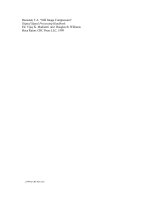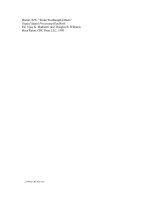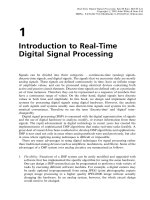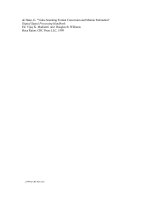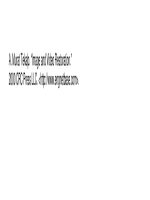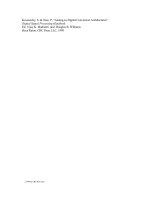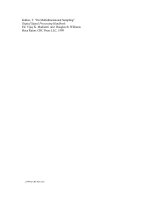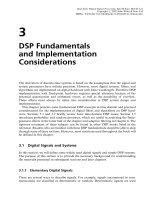Personal Computers and Digital Signal Processing pdf
Bạn đang xem bản rút gọn của tài liệu. Xem và tải ngay bản đầy đủ của tài liệu tại đây (7.17 MB, 121 trang )
2
IDC Technologies
Personal Computers and Digital Signal Processing
3
Personal Computers and Digital Signal Processing
© 2012 IDC Technologies & Ventus Publishing ApS
ISBN 978-87-403-0001-7
Personal Computers and Digital Signal Processing
4
Contents
Contents
Foreword 7
1 e Personal Computer 9
1.1 8086 Segmented Memory Architecture 9
1.2 System Components 9
1.4 Industry Standard Architecture (ISA) Bus 12
1.5 Polled Data Transfer 17
1.6 ISA Interrupts 17
1.7 ISA DMA 18
2 Digital Signal Processing 20
2.1 Digital Filtering 20
2.2 Correlation Techniques 27
3 Converting Analog to Digital Signals and Vice Versa 31
3.1 A Typical DSP System 31
3.2 Sampling 32
3.3 Quantization 42
3.4 Analog-to-Digital Converters 53
3.5 Analog Reconstruction 59
Personal Computers and Digital Signal Processing
5
Contents
3.6 To Probe Further 66
3.7 Contact the Manufacturers 67
Appendix A
Glossary of Terms 68
Appendix B
Units and Abbreviations 97
Appendix C
Commonly used Formulae 100
Symbols used in formulae 100
Formulae 102
Appendix D
Resistor Color Coding 107
Common Band Colors 108
Appendix E
Binary Encoding of
Quantization Levels 109
Personal Computers and Digital Signal Processing
6
Contents
Who is IDC Technologies 111
e Benets to You of Technical Training 111
Technical Training Workshops 111
Soware 115
Hands-On Approach to Training 115
On-site Workshops 116
Customized Training 117
Training Contracts 117
IDC Technologies - Worldwide Oces 119
Australia 119
Personal Computers and Digital Signal Processing
7
Foreword
Foreword
IDC Technologies specializes in providing high quality state-of-the-art technical training workshops to engineers, scientists
and technicians throughout the world. More than 300,000 engineers have attended IDC’s workshops over the past 16
years. e tremendous success of the technical training workshops is based in part on the enormous investment IDC
puts into constant review and updating of the workshops, an unwavering commitment to the highest quality standards
and most importantly - enthusiastic, experienced IDC engineers who present the workshops and keep up-to-date with
consultancy work.
e objective of this booklet is to provide today’s engineer with useful technical information and as an aide-memoir
when you need to refresh your memory. is 5th edition of the Pocket Guide Series has been updated to include new
information including Personal Computing and Digital Signal Processing.
Concepts that are important and useful to the engineer, scientist and technician, independent of discipline, are covered
in this useful booklet.
Although IDC Technologies was founded in Western Australia in 1986, it now draws engineers from all countries. IDC
Technologies currently has oces in Australia, Canada, Ireland, Malaysia, New Zealand, Singapore, South Africa, UK
and USA.
We have produced this booklet so that you will get an in-depth, practical coverage of Communications, LANs and TCP/
IP topics. Information at an advanced level can be gained from attendence at one of IDC Technologies Practical Training
Workshops. Held across the globe, these workshops will sharpen your skills in today’s competitive engineering environment.
Other books in this series
INSTRUMENTATION
Automation using PLCs, SCADA and Telemetry, Process
Control and Data Acquisition
COMMUNICATIONS
Data Communications, Industrial Networking, TCP/IP and
Fiber Optics
ELECTRICAL
Power Quality, Power Systems Protection and Substation
Automation
FORMULAE & CONVERSIONS
Electrical & Electronics Engineering, Mechanical Engineering,
Thermodynamics, Fluid Mechanics, General Mathematics
INDUSTRIAL AUTOMATION
Process Control, Instruments and Valves, Industrial Data
Comms, HAZOPS, Safety Instrumentation, Hazardous Areas,
SCADA and PLCs
Personal Computers and Digital Signal Processing
8
Notes
Personal Computers and Digital Signal Processing
9
The Personal Computer
1 The Personal Computer
e original Personal Computer (PC) was introduced by IBM in September 1981. Since then many dierent models have
been developed and marketed by IBM and by many other manufacturers.
is chapter discusses the most important features of the PC and in particular how they relate to engineers, technicians
and scientists.
ere are ve main types of microprocessors found in PCs. ese are the 8088/8086, 80286, 80386, 80486 and the Pentium,
all originally designed and sourced by Intel.
1.1 8086 Segmented Memory Architecture
All the various PC microprocessors have their origin in the Intel 8086 microprocessor. is is a 16-bit processor with a
16-bit data bus and 20-bit address space, which allows 220 = 1,048,576 bytes or 1 MB of memory to be accessed.
e address registers of the 8086 are 16 bits wide and can only address 64 KB of memory. To obtain the real address of a
memory location, the CPU adds the oset, contained in a CPU register, to the contents of a 16-bit segment register that
has been shied four bits to the le, to provide for the extra four address lines. us, the processor accesses memory in
64 KB segments, with the position of the segments in the address range controlled by the four segment registers.
is confusing and inecient addressing scheme was inherited because of a need to maintain compatibility with earlier
generations of processors. More recent processors, that is from the 80386 onwards, use full 32-bit addressing.
1.2 System Components
A few of the system components that are contained in a typical PC are discussed below. ese are:
• memory and memory expansion
• display systems
• Industry Standard Architecture (ISA) bus
A brief discussion is then given of:
• polled data transfer
• ISA interrupts
• ISA DMA
1.3 Memory and Memory Expansion
ere are three main classications of memory used in PC systems. ese are:
Personal Computers and Digital Signal Processing
10
The Personal Computer
• base memory
• expanded memory
• extended memory
Base Memory
e memory from address 0 up to either the amount of memory installed in the computer or address FFFFFh (that is, up
to a total of 1 MB) is called base memory. e rst 640 KB of this is RAM and is normally used by the operating system
and application programs. e remaining 384 KB of address space is reserved for the BIOS ROM and other adaptor
ROMs, display adaptor memory, other adaptor memory and expanded memory.
Expanded Memory System (EMS)
Early processors (the 8086/8088), and all other PC processors running in real mode, are limited to a memory space of
1 MB because only the rst 20 address lines are available. e same is true for DOS, being a 16-bit operating system. To
make more memory available for applications, a scheme was developed by Lotus, Intel and Microso called Expanded
Memory of which LIM EMS 4.0 is a common version.
In hardware, a second linear array of memory, called the logical expanded memory, is designed into a system. is
can be up to 32 MB in size. A block of memory space is then set aside in the high memory area (normally 64 KB) and
divided into four separate 16 KB pages. is acts as a window into the expanded memory. us, four pages of the actual
expanded memory are accessible at any one time through the window in high memory. ese windows are called page
frames. e required portion of expanded memory is mapped into the page frame through registers in the computer’s
I/O space. Figure 1.1 illustrates the concept.
Figure 1.1 Organisation of Expanded Memory
e management of the memory is handled by the Expanded Memory Manager (EMM) which is an operating system
extension normally installed at system startup. Application programs use the expanded memory for data. It is not usually
possible to place program code in EMS. e application program communicates with the EMM via soware interrupt
67h and accesses the memory via a far pointer into the page frame.
Personal Computers and Digital Signal Processing
11
The Personal Computer
Extended Memory (XMS)
Extended memory is the physical linear memory found above the 1 MB mark. 80286 and 80386SX processors can address
up to 16 MB of base and XMS while 80386DX and 80486 processors can address up to 4 GB of this type of memory. XMS
is memory addressed directly by the processor (and hence the application program) and is therefore simpler, quicker
and more ecient. Extended memory is only available as normal application memory when the processor is in protected
mode; it follows that only 32-bit protected mode systems and extensions — such as OS/2, UNIX and MS-Windows but
not DOS — can make this memory available to programs.
Display Systems
e 1024 x 768 Extended VGA is the de-facto standard for PC systems today. VGA adaptor boards have several
programmable components, including a CRT controller, a sequencer, an attribute controller and a graphics contoller.
e VGA ROM BIOS on the board contains a set of routines that perform screen I/O and display conguration. ese
routines, callable through interrupt 10 h, include functions to:
• set the video mode
• control the position and shape of the cursor
• read and write characters to the screen
• set the color palette
• read and write individual pixels
• obtain status information
e display may be congured into various modes which are dierent in the following ways:
• vertical resolution
• horizontal resolution
• data representation in the video buer memory
• attribute decoding (colors, blinking and intensity)
e screen image is completely refreshed between 43.5 and 70 times per second, depending on the video mode. As each
line of pixels is displayed the red, green and blue signals produced by the VGA board modulate the intensity of the electron
beam. e scan cycle begins with the rst pixel of the displayed video buer data near the top le of the screen. e monitor
moves the beam from le to right at a constant rate across each scan line and downward from scan line to scan line.
e VGA board produces a horizontal synchronization (or sync) signal that controls the timing of the deection of the
beam from the right hand end of the previous scan line to the start of the next scan line. e deection is called the
horizontal retrace.
e VGA board also produces a vertical synchronisation signal that controls the deection of the beam from the end of
the bottom scan line back to the top le of the screen. is is called the vertical retrace.
Personal Computers and Digital Signal Processing
12
The Personal Computer
1.4 Industry Standard Architecture (ISA) Bus
e ISA bus signals are divided into four groups according to their function:
• address and data bus signal group
• data transfer control signal group
• bus arbitration signal group
• utility signal group
Figure 1.2 ISA Signal Mnemonics, Signal Directions and Pin Locations
Address and Data Bus Signal Group
is group contains the signal lines that are used to address memory and I/O devices and the signal lines used to transfer
the actual data.
Personal Computers and Digital Signal Processing
13
The Personal Computer
• D[7 0]
D[7 0] are the low eight bits of the 16-bit bidirectional data bus used to transmit data between the microprocessor,
memory and I/O port.
• D[15 8]
D[15 ] are the high eight bits of the 16-bit bidirectional data bus. ey are similar to the lower eight data
lines, D[7 0].
• LA[23 17]
e LA17 to LA23 (latchable address) lines form part of the latchable address bus.
• SA[19 0]
Address lines SA0 through SA19 are used to address system bus I/0 and memory devices. ey form the
lower-order 20 bits of the 32-bit address bus (however, only 24 of the 32 address lines are normally available
in ISA systems).
Personal Computers and Digital Signal Processing
14
The Personal Computer
• /SBHE
/SBHE (System Bus High Enable) is an output-only signal. When low, it indicates to the expansion board that
the present cycle expects to transfer data on the high half of the D[15 0] data bus.
• AEN
When low, AEN (Address Enable) indicates that an I/O slave may respond to addresses and I/O commands
on the bus.
Data Transfer Control Signal Group
is group contains signals that are used to control data transfer cycles on the bus.
• BCLK
BCLK (Bus Clock) is provided to synchronise events with the main system clock.
• BALE
When high, BALE (Address Latch Enable) indicates that a valid address is present on the latchable address lines
LA17 to LA23. It goes high before the addresses are valid and falls low aer they have become valid.
• /MRDC
is signal is asserted by the system board or ISA bus master to indicate that the addressed memory slave
should drive its data onto the system data bus.
• /SMRDC
is memory-read signal is derived from /MRDC and has similar timing, the dierence between the two is that
/SMRDC is only active for addresses between Oh and 000FFFFFh (that is, in the rst megabyte of memory).
• /MWTC
is signal is asserted by the system board or ISA bus master to indicate that the addressed memory slave may
latch data from the system data bus.
• /SMWTC
is memory-write signal is derived from /MWTC and has similar timing; the dierence between the two is that
/SMWTC is only active for addresses between Oh and 000FFFFFh (that is, in the rst megabyte of memory).
Personal Computers and Digital Signal Processing
15
The Personal Computer
• /IORC
e I/0-read signal is asserted by the system board or ISA bus master to indicate that the addressed I/0 slave
should drive its data onto the system data bus.
• CHRDY
An expansion device may use CHRDY (CHannel ReaDY) to lengthen a bus cycle from the default time.
• /NOWS
e /NOWS (NO Wait State) signal may be driven by a memory device aer it has decoded its address and
command to indicate that the remaining BCLK periods in the present cycle are not required.
• /M16
If the addressed memory is capable of transferring 16-bits of data at once on the D[15 0] datalines, it may
assert /M16, aer decoding a valid address.
• /1016
If the addressed I/0 port is capable of transferring 16-bits of data at once on the D[15 0] datalines, it may assert
/IO16, aer decoding a valid address.
Bus Arbitration Signal Group
ese signals are used to arbitrate between devices and the system board for control of the bus.
• DRQ[7 5] and DRQ[3 0]
e DRQ (DMA request) lines are used to request a DMA service from the DMA subsystem, or for a 16-bit
ISA bus master to request access to the system bus. e request is made when the DRQ line is driven high and
may be asserted asynchronously.
• T-C
T-C (Terminal Count) is a bidirectional signal acting in one of two modes, depending on the programming
of the DMA channel. In output mode, the system board asserts T-C to indicate that a DMA channel’s word
count has reached its terminal value.
• /MASTER16
Personal Computers and Digital Signal Processing
16
The Personal Computer
is signal allows bus master cards to take over the system bus. A master asserts /MASTER16 when it receives
a /DAK signal from a DRQ on its DMA channel.
• /REFRESH
When low, /REFRESH indicates that a refresh cycle is in progress. is causes SA[15 0], or LA[15 2], to drive
the row address inputs of all DRAM banks so that when /MRDC is asserted, the entire system memory is
refreshed at one time.
Utility Signal Group
• OSC
OSC is a clock signal for use in general timing applications. Its frequency is 14.31818 Mhz (roughly 70 ms)
with a duty cycle of 50%.
• RESDRV
RESDRV (reset driver) is an output signal which, when asserted, produces a hardware reset for devices attached
to the bus.
• IRQ[15 14]
Personal Computers and Digital Signal Processing
17
The Personal Computer
• IRQ[12 9]
• IRQ[7 3]
e input-only interrupt lines are used by expansion boards to interrupt the CPU to request some service.
• /IOCHK
An expansion board can assert /IOCHK (I/0 channel check) to indicate that a serious error has occurred.
1.5 Polled Data Transfer
e term polled data transfer refers to the transfer of data, to or from the CPU, that are initiated by a CPU instruction.
ese are memory and I/O reads and writes.
ere are two sizes of data transfer: 8-bit and 16-bit, each with its own default timing. For backward compatibility with
8-bit devices, if a 16-bit instruction is executed by the CPU and the expansion board does not indicate that it is a 16-bit
device (with either the /M16 or /IO16 signals), then the system board performs data bus translations. e 16-bit operation
is converted into two 8-bit operations, and two 8-bit cycles are run instead of a single 16-bit cycle.
e 80286, 80386 and 80486 processors have a machine cycle consisting of two clock periods or states. ese are called
TS, send status and TC, perform command. e processor machine cycle may be extended by additional command (TC)
states when the processor is in the command state by driving its /READY input. is is achieved on the ISA bus with the
CHRDY signal, and the additional TC states are called wait states.
Wait states are added by the system board to ensure compatible timing. ey may also be added and reduced by expansion
boards. As BCLK, the I/O clock, is generally slower than the CPU clock, the system board lengthens the periods of the
machine states in machine cycles that are to be run on the I/O bus. For example, if the CPU clock is 40 Mhz and the I/O
clock is 10 Mhz, each T state in an I/O cycle will be lengthened by a factor of four over that of the main CPU.
1.6 ISA Interrupts
Interrupts provide the computer with a means of attending to important events on demand when they occur. Examples of
such events are key strokes and COM port data. Interrupts allow the CPU to execute the main program and process only
I/O data when it is available, instead of having to poll the I/O devices regularly, just in case there might be data available
or a service to perform. is makes better use of CPU time, and is highly eective for fairly low-speed data transfer or
event reaction (20 to 40 kHz max on a 40 MHz 386).
An interrupt is not an expansion bus cycle but a cycle on the computer system board, as noted above. e only hardware
signalling, an adaptor performs to request an interrupt service from the CPU, is to drive its interrupt line from the low
to the high state and keep it there until the interrupt is serviced. Any actual data transfer cycles are carried out by the
soware, using the CPU as discussed in the previous section on polled data transfer. e soware data transfer is initiated
by an interrupt signal.
Personal Computers and Digital Signal Processing
18
The Personal Computer
ere are three groups of interrupts that can occur in a PC system:
• Hardware Interrupts - where a device asserts its interrupt line
• Soware Interrupts - generated when the CPU executes an interrupt instruction in program code
• Processor Exceptions - generated when an illegal operation is performed in the soware (for example
division by zero)
Interrupts all function in the same way. e rst 1 KB of system memory is reserved for what are called interrupt vectors.
An interrupt vector is a memory location (actually four memory locations) containing the starting address of a section of
code that is executed when the corresponding interrupt occurs. e section of code that is executed is called an Interrupt
Service Routine (ISR).
Each interrupt vector consists of the low and high bytes of the ISR’s segment address and low and high bytes of the ISR’s
address oset with the segment. ese form the CS:IP values for the CPU to jump to when the corresponding interrupt
occurs. erefore, in 1 KB of memory, 256 dierent interrupt vectors may be stored. ese are called interrupt types.
1.7 ISA DMA
ISA Direct Memory Access (DMA) cycles operate in single mode, since a DMA request initiates one DMA cycle in which
one data transfer occurs. DMA allows the direct transfer of data from I/O devices to memory devices and vice versa (and
from memory to memory) without involving the CPU. is makes it possible to transfer large amounts of data to and
from memory in the background, at high speed.
e DMA system is based on two 8237-type DMA controllers. Controller 2 provides DMA channels 5, 6 and 7 as well
as the cascade input for controller 1.
e 8237 device only supports 16-bit addresses (limiting access to 64 KB of memory). Each DMA channel has an associated
page register on the main board to provide the additional addresses, so that up to 16 MB of memory may be accessed via
DMA. is means that if more than 64 KB is to be transferred via DMA, the page register must be reprogrammed aer
each 64 KB block and a new block of DMA transfer started. is can lead to time gaps in the DMA transferred data if
the data is arriving at high speed from a real-time data acquisition expansion board.
A technique called Dual Channel DMA can be used to overcome the problems with time gaps in the DMA transferred
data. Two DMA channels are used in an alternating manner. Channel 1 is used rst to transfer data into memory while
Channel 2 is being programmed. When 64 KB of data has been transferred the second DMA channel is used and the
rst DMA channel is reprogrammed.
Personal Computers and Digital Signal Processing
19
Notes
Personal Computers and Digital Signal Processing
20
Digital Signal Processing
2 Digital Signal Processing
Digital Signal Processing (DSP) is formally dened as a digital operation performed on an input sequence of numbers
(including feedback from the result of the digital operation). e sequence of numbers can represent anything from
digitised human speech to stock price data, processed to detect hidden periodicities or patterns.
Typical DSP operations include:
• Digital ltering (low-pass, bandpass, high-pass, bandstop and multiple-band lters).
• Discrete Fourier Transforms (especially the Fast Fourier Transforms) to analyze the periodic frequency
content of a signal.
• Signal modulation (generation of sinusoidal waveforms).
• Autocorrelation (for analysis of periodic signals in a single-input signal).
• Cross-correlation (used to determine frequency and time relationships between two dierent but related
signals).
Digital ltering and correllation techniques will be disussed in the following sections.
2.1 Digital Filtering
Digital ltering is a commonly used DSP procedure and is relatively easy to implement. A digital lter is a numerical
procedure, or algorithm, that transforms a given sequence of numbers into a second sequence that has more desirable
properties, such as less noise or distortion.
A digital lter consists of the interconnection of three simple elements: adders, multipliers and delays. e adder and
multiplier are components that are readily implemented in the arithmetic logic unit of the computer. Delays are components
that allow access to future and past values in the sequence.
When a lter produces a unit-sample response of innite duration, it is called an Innite Impulse Response (IIR) lter.
As this requires a recursive structure (the output is a function of past outputs), the terms IIR and recursive are commonly
accepted as interchangeable when applied to digital lters. An IIR lter can go to innity if it enters an unstable state
aer a unit pulse at the input.
A lter with a nite unit-sample response is called a Finite Impulse Response (FIR) lter. e term is used interchangeably
with non-recursive because the output is a function of inputs only. An exception is the frequency-sampling structure for
FIR lters, which does require recursion for the required response. An FIR lter eventually settles back to zero aer a
unit pulse at the input.
Figure 2.1 illustrates the two types of lters. (Note that the z-1 is a shorthand method of indicating delays; it also has
mathematical signicance).
Personal Computers and Digital Signal Processing
21
Digital Signal Processing
Figure 2.1 Representation of a digital lter
For example, if an analog voltage signate f(t) is sampled at discrete regular time intervals ∆t as follows:
f(t), f(t+³t), f(t+2³t), f(t+k³t)
and t=0 (to make it easier), the sequence of voltage samples becomes:
f(0), f(0+³t), f(0+2³t), f(0+k³t)
is can be represented with the z transforms as:
f(0) + f(1)z
-1
+ f(2)z
-2
+ f(3)z
-3
+ f(k)z
-k
e variable z-k can be interpreted as a type of operator that, upon multiplication, shis signal samples to the right
(delays) by k time units.
Figure 6.1 demonstrates how any discrete time (or digital) lter with input x(k) and output y(k) can be represented with
the general dierence equation:
b
0
y(k) + b
1
y(k-1) + + b
M
y(k-M) = a
0
x(k) + a
1
x(k-1) + +a
N
x(k-N)
us:
2.0
Personal Computers and Digital Signal Processing
22
Digital Signal Processing
In combining these components, we get a ltered output y
n
. e process of implementation of these equations, to a set of
data, is therefore called digital ltering. e resultant equations are known as dierence equations.
is means that input samples enter at the le end of the diagram and move to the right through each delay element as
each new sample is ready. e newest input sample is x(k). e previous input sample delayed by one sample period is
x(k-1). e sample before it is x(k-2) and so on. With each new sample, a sum of products cycle is performed in which
current and past inputs are multiplied by their respective coecients.
Taking the Z-transform of the above equation, this becomes:
2.1
is means that X(z) and Y(z) are represented as:
2.2
2.3
e discrete time (or digital) transfer function can thus be dened as:
Personal Computers and Digital Signal Processing
23
Digital Signal Processing
2.4
2.5
is can also be written as:
Y(z) = H(z)X(z)
e output sequence is then obtained using the inverse z-transform.
A special case of this equation can be obtained for the unit pulse input sequence where:
2.6
which results in a Z-transform X(z)=1. e response to this input is therefore the inverse z-transform of H(z).
FIR lters have the advantage of being completely stable and possess linear phase shi. ey use only past and current
inputs and do not have any counterparts in the analog world. IIR lters produce better performance with fewer coecients,
but lack some of the advantages of the FIR lters. Because IIR lters use feedback of past outputs into the output, they
can be unstable - although proper design overcomes the problem.
e coecients, which dictate lter response, are usually based around the response of a lter to an impulse function
(x
n
=1 n=0, x
n
=0<>0). By then working backwards from the impulse response, the coecients (or transfer function) for
the lter are deduced.
e non-recursive lter transfer function follows from Equation 6.7 for all bm=0.
2.7
e corresponding dierence equation is:
2.8
2.9
With an impulse input:
Personal Computers and Digital Signal Processing
24
Digital Signal Processing
we get the output
2.10
where
which gives
h
n
=a
n
thus giving a more usable transfer function for a discrete system
2.11
where:
z=e
jwT
Knowing that the transfer function H(z) is a periodic function of frequency, and also knowing the frequency response
that is required, the Fourier series can then be used to obtain the coecient series hn.
2.12
2.13
where:
2š/w0 is the period of f(t)
cn is the frequency spectrum
Conversely, in reversing the time-frequency role, we get:
2.14
Personal Computers and Digital Signal Processing
25
Digital Signal Processing
2.15
where:
a
n
is the time domain sequence of numbers for the impulse response
w
s
is the sampling frequency
w
s
equals 2š/T where T = sampling period
Using Nyquist’s theorem, which states sampling frequency should be at least double the maximum frequency to be sampled,
+ w
s
/2 is thus the maximum cuto frequency, so:
2.16
where:
w
c
= cuto frequency [RT1] w
s
/2
